การส่งเสริมกระบวนการย่อยสลายทางชีวภาพในแหล่งน้ำเสียชุมชนที่มีไนโตรเจนสูง โดยเพิ่มแหล่งคาร์บอนภายนอก PROMOTE BIODEGRADATION OF HIGH CONTAMINATED NITROGEN DOMESTIC WASTEWATER BY EXTERNAL CARBON
Keywords:
Domestic wastewater, Biodegradation, External carbonAbstract
At present the population increased from more consumption cause water pollution. Especially the contamination of nitrogen that found in Domestic wastewater. If there isn’t enough carbon biodegradation process will slow down. Therefore, add enough external carbon that to promote biodegradation process. This research aimed to study the optimum ratio of carbon in high-nitrogen wastewater from the Domestic wastewater of at Kasetsart University. To promote the biodegradation process using external carbon such as sucrose and ethanol in both in aerobic and anaerobic conditions, which have the C:N ratio of COD:NH3 was 3:1, 5:1 and 7:1 while the hydraulic retention time (HRT) of 24, 48, 72 and 96 hours respectively were used. The results showed that 5:1 ratio of aerobic condition using sucrose as a carbon source and HRT of 48 hours has the highest treatment efficiencies of NH3-N which was 83.03% from 311.5 mg/L reduce to 52.86 mg/L. While when there was add enough oxygen in the wastewater that oxygen dissolved more than 4 mg/L. The same ratio and HRT case the treatment efficiencies of NH3 to be 100% by the nitrification process that oxidize NH3 into NO3- using Aerobic bacteria. As a result, the NO3- increased from 48 mg/L to 355 mg/L.Therefore, nitrate treatment is carried out in anaerobic conditions following the conditions when there was enough oxygen. At the HRT of 48 hours, where the treatment efficiency of NO3- was 100%. Concluding the experiment that sucrose can be used as an external carbon to promote the biodegradation process in high-nitrogen wastewater.
Downloads
References
[2] Kiangsak Udomsinroj. (2543). Wastewater removal engineering. Bangkok. Prince of Songkla University.
[3] Walaiporn Vuthimatha. (2551). The Role of COD/Nitrate Ratio on Microbial Diversity in UASB Process. Master of Master of Engineering. (Environmental Engineering). Bangkok: Chulalongkorn University.
[4] Moore-landecker, E. (1996). Fundamentals of the fungi. 4th ed. U.S.A.: Prentice-Hall.
[5] Standard Methods. (1998). Standard Methods for the Examination of water and Wastewater. 4th ed. U.S.A.: American Public Health Association, Washington, DC.
[6] Pochana, k., & Keller, J. (1999, July). Study of factors affecting simultaneous nitrification and denitrification. Water Science and Technology, 39(6), 61-68.
[7] Rittman, B., & Langeland, W. (1985). Simultaneous denitrification with nitrification in single-channel oxidation ditches. Journal of the Water Pollution Control Federation, 57(4), 300-308.
[8] McCarty, G.W. (1999, April). Modes of action of nitrification inhibitors. Biology and Fertility of Soils, 29(1), 1-9.
[9] Bitton, G. (2005). Wastewater Microbiology. America: Wilry-Liss, Inc.
[10] Metcalf, & Eddy. (1991). Wastewater Engineering Treatment and Reuse. Boston: McGraw-Hill.
Downloads
Published
How to Cite
Issue
Section
License
Srinakharinwirot University Journal of Sciences and Technology is licensed Under a Creative Commons Attribution-NonCommercial-NoDerivs 4.0 International (CC-BY-NC-ND 4.0) License, Unless Otherwise Stated. Please Read Journal Policies Page for More Information on Open Access, Copyright and Permissions.



